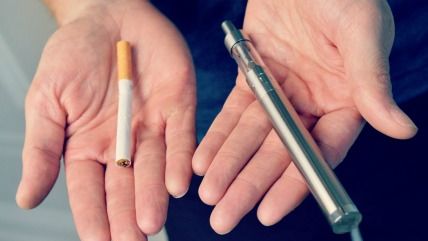FDA Imposes a Slow-Motion Ban on E-Cigarettes
The agency's final rule leaves conventional cigarettes on the market while requiring much safer alternatives to meet prohibitive requirements.

Today the Food and Drug Administration (FDA) announced what amounts to a slow-motion ban on e-cigarettes, ignoring the pleas of harm reduction advocates who say it makes no sense to prevent smokers from switching to nicotine products that are indisputably much less hazardous than the ones they are using now. The FDA rule, a preliminary version of which was published two years ago, effectively requires e-cigarette manufacturers to get their products approved as "new tobacco products," an expensive, arduous, and time-consuming process that will be prohibitive for most of them.
Each application is expected to cost $1 million or more, and a separate application will be required for each version of a product—an impossible burden for small businesses that sell vaporizers along with dozens of custom-made fluids. Even large companies that can afford to apply for approval may be unable to persuade the FDA that "permitting such tobacco product to be marketed would be appropriate for the protection of the public health," a requirement set by the Family Smoking Prevention and Tobacco Control Act. Such appropriateness "shall be determined with respect to the risks and benefits to the population as a whole, including users and nonusers of the tobacco product, and taking into account (A) the increased or decreased likelihood that existing users of tobacco products will stop using such products; and (B) the increased or decreased likelihood that those who do not use tobacco products will start using such products."
The "population as a whole" standard means the FDA may reject products even when they are clearly much less dangerous than conventional cigarettes (as e-cigarettes are), based on concerns about how nonsmokers might react to them. Will teenagers who otherwise never would have tried tobacco experiment with e-cigarettes, get hooked on nicotine, and then move on to smoking? There is very little evidence that is happening, but how can a company prove to the FDA it won't happen? And when it comes to assessing the relative hazards of vaping and smoking, will the FDA be satisfied by the observation that e-cigarettes, as noncombustible, tobacco-free products, produce far fewer toxins in much smaller amounts than conventional cigarettes do? Or will it demand long-term research that is impossible given the short history and uncertain future of e-cigarettes?
The FDA's press release, which parrots the CDC's scientifically absurd position that increases in adolescent vaping wipe out the public health gains from decreases in adolescent smoking, does not bode well for companies that hope to meet the agency's demands. "While there has been a significant decline in the use of traditional cigarettes among youth over the past decade," the FDA says, "their use of other tobacco products continues to climb." The FDA, like the CDC, counts e-cigarettes as "other tobacco products," even though they contain no tobacco. That label implies a false equivalence. "As cigarette smoking among those under 18 has fallen, the use of other nicotine products, including e-cigarettes, has taken a drastic leap," says Health and Human Services Secretary Sylvia Burwell. "All of this is creating a new generation of Americans who are at risk of addiction. Today's announcement is an important step in the fight for a tobacco-free generation."
Burwell seems to think that what matters is the "risk of addiction," as opposed to the risk of smoking-related disease. She also seems to believe that a "tobacco-free generation" is one that not only consumes no tobacco but does not dabble in e-cigarettes either—even the nicotine-free kind, by far the most popular choice among teenagers. If these are the principles that will guide the FDA's regulatory decisions, the e-cigarette industry is well and truly screwed.
But not immediately. "The FDA expects that manufacturers will continue selling their products for up to two years while they submit—and an additional year while the FDA reviews—a new tobacco product application," the agency says. "The FDA will issue an order granting marketing authorization where appropriate; otherwise, the product will face FDA enforcement."
An amendment approved by the House Appropriations Committee last month would protect the vaping industry from that threat by allowing e-cigarettes currently on the market to stay there without winning approval as new tobacco products. (The current grandfather date is February 15, 2007, when the industry barely existed.) Even that solution would impede innovation and safety improvements, since pre-market approval would still be required for new products. The FDA's regulatory scheme, in other words, privileges the most dangerous nicotine delivery devices (conventional cigarettes) while threatening to eliminate much safer alternatives and blocking the introduction of even better products. All in the name of public health.




Show Comments (161)